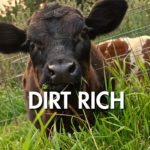Dirt Rich Episode 48: Grazing Cattle to Restore Oak Savanna
Using livestock to restore landscapes may seem like a contradiction, but oak savannas thrive with disturbance. Grazier Doug Voss and PhD candidate Austin Yantes are involved in a project at the Sherburne National Wildlife Refuge, studying the results of carefully managed cattle grazing, tree thinning, and burning in striving to meet Sherburne’s ecological goals.
The Sherburne National Wildlife Refuge is located near Zimmerman, Minnesota on the Anoka Sand Plain. Prior to European settlement, the refuge was dominated by oak savanna. At that time, the disturbances the landscape was dependent on would have been indigenous fire management, dry soils, and elk and bison grazing. Since European settlement, 90% of the oak savanna is estimated to have been lost.
Yantes says that it’s worth restoring the oak savanna because of the landscape’s uniqueness. The dynamic patterns of disturbance can support a higher diversity of plant species, which provides good habitat for animals and insect species. By layering the tools of intensely managed cattle grazing, thinning trees, and controlled burning, the research project hopes to illuminate the most effective management practices to meet the refuge’s goals. “One of my favorite things about this project is it’s such a cool way to manage landscapes that integrates both livestock production but also ecological restoration and conservation goals,” says Yantes.
Listen here: https://dirtrichmn.podbean.com/e/48-grazing-cattle-to-restore-oak-savanna-in-the-sherburne-national-wildlife-refuge/

